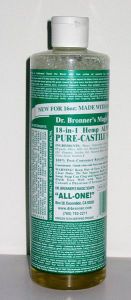By Catherine Haug, April 13, 2017 (posting originally published on The EssentiaList, the community/sustainability blog for which I am the editor) Updated Oct 2018 to provide information on using bleach to disinfect the area being cleaned.
Daily Inter Lake had an interesting piece by Kathryn Houghton in April 2017, titled “Spring Cleaning. Officials: Rats carrying hantavirus can be deadly.” A similar but shorter article was in April 5, 2018 issue of the Daily InterLake (1). These caught my eye because it’s time to clean out my garage from all the salty dirt brought in on my car’s tires (I call them “tire turds”), and also to sort through my old moving boxes (after moving them from storage in Portland) for my enameled cookware. You can read the complete article at reference (1) below, but read on for the highlights of those articles and my own additions.
See also: 1. Cleaning, Pest Control, & Personal Care Menu
Note about pets and hantavirus
- “Cats can be infected by hantavirus but will show no symptoms, therefore the virus is not dangerous to them. In addition, cats cannot transmit hantavirus to people.” (10a)
- Dogs cannot be infected with hantavirus, but they can show symptoms similar to hantavirus that requires medical attention. (10b)
About Hantavirus
More information on hantavirus and its prevention can be found on the Department of Public Health and Human Services (DPHHS) website (6) and search “hantavirus” to get other related articles. The following is my distillation of their info.
- Rodents (not just rats) carry the virus.
- Montana has one of the highest rates of infection in the US. About 25% of Montana’s cases have resulted in death.
- The virus is spread in dusty air; sweeping, vacuuming and other cleaning activities can stir up dust infected by saliva, urine or droppings from infected rodents.
- Symptoms include: fatigue, fever, muscle aches early in the cycle. As the pulmonary disease progresses, symptoms will include coughing and extreme shortness of breath.
- Precautions: see below.
Precautions and Method:
You will need:
- Rubber or plastic gloves;
- Spray bottle. for bleach-water solution in small areas;
- Pail to mix bleach into water for large areas;
- Rags for small areas;
- Mop or swamping broom for large areas.
- Wearing a mask is optional – not an ordinary mask but rather a “half-mask air-purifying (or negative- pressure) respirator with an N-100 filter or a powered air-purifying respirator (PAPR) with N- 100 filters.” (9)
Method: As you do your cleaning in areas where there is evidence of rodent activity, you should take the recommended precautions, as provided by the Montana Department of Public Health (6), but I’ve expanded on their text:
- Avoid sweeping or vacuuming areas with rodent droppings and urine, as the action can stir up dust and aerosolize the droppings.
- If cleaning an area such as a cabin, camper or outbuilding, open windows and doors to air-out the space for 30 minutes prior to cleaning.
- Wear rubber or plastic gloves. You may also wear a mask, though it may not provide much protection unless you use a “half-mask air-purifying (or negative- pressure) respirator with an N-100 filter or a powered air-purifying respirator (PAPR) with N- 100 filters.” (9)
- Clean up urine or droppings first, using a disinfectant or a mixture of bleach and water to reduce dust. See below for bleach/water ratios.
- Make sure the droppings, etc., are thoroughly wet, and let them soak 5 minutes.
- Wipe up soaked droppings with a sponge or paper towel and discard after use.[Cat’s recommendation: put discarded items in a plastic bag (such as a grocery bag), tie bag closed, and place in the trash container.]
- Then thoroughly clean area as described, next.
- Clean floors and other surfaces next. Spray with the bleach or other disinfectant solution, soak 5 minutes, then mop floors with more bleach solution.
- If doing a large area such as a garage floor, and the area is well ventilated, you can use a wet/dry vac (7) after the area has soaked with bleach solution for 5 minutes. Dump contents into garbage can and give the wet vac a good wash with bleach/water mix afterward. See Maids By Trade (8) for how to clean the wet/dry vac with bleach
- If area is not well ventilated, a wet/dry vac is not recommended unless you have a long hose for your wet/dry vac so the vac can sit in a more well-ventilated area. This is because the vac exhales the air it took in, which may contain the virus. (11)
- If not using a vac, it may be better to do one smaller area at a time; perhaps 1 square yard increments.
- Be sure to clean and disinfect the entire area with disinfectant or bleach solution.
- Before taking off your gloves, clean them with disinfectant (more bleach solution). Discard gloves.

- After removing gloves: Wash hands thoroughly with soap and warm water after removing and discarding the gloves. [Cat’s note: use real soap such as Dr. Bronner’s (image above), Kirk’s Castile (1), or homemade soap, as these are antimicrobial. Commercial ‘soaps’ are really detergents and have little-to-no antimicrobial ability.] Image of Dr Bronner’s liquid Castile soap, right, from Wikimedia Commons.
How to Make the Bleach/Water Solution
There are two concentrations of bleach on the market (see photo of Clorox brand products), that can be diluted with water as follows:
-
- Using old formula, 6% hypochlorite bleach: mix 1 1⁄2 cups of bleach with 1 gallon of water. Smaller amounts can be made with 1 part bleach and 9 parts water. (3)
- Using “Concentrated Regular Bleach” (8.25% hypochlorite on the label): mix ½ cup concentrated bleach per gallon of water. Smaller amounts can be made with 2 Tbsp bleach per quart of water. (4)
NOTE: Mixture breaks down rather quickly; make a new batch after 24 hours.
More information on hantavirus and its prevention can be found on the Department of Public Health and Human Services (DPHHS) website (6) and search “hantavirus” to get other related articles.
References:
- Daily Inter Lake articles:
- Amazon image of Kirk’s Castile: ecx.images-amazon.com/images/I/41LQqVcX9KL.jpg
- Bleach/water ratio using regular chlorine bleach (not concentrated): healthallianceyourhealthconnection.org/?p=545
- Bleach/Water ratios using concentrated chlorine bleach: modernsurvivalblog.com/health/disinfectant-bleach-water-ratio/
- Bleach image: totallyunprepared.com/2014/08/how-bleach-has-changed-and-what-you-need-to-do-about-it/
- MT DPHHS website: dphhs.mt.gov
- Using wet-dry vacuum: doityourself.com/stry/how-to-use-a-wet-dry-vacuum-cleaner
- Cleaning wet-dry vac with bleach: maidsbytrade.com/clean-shop-vacuum/
- CDC on mask recommendation: cdc.gov/hantavirus/technical/hps/faq.html; scroll down to item 5.
- Pets and hantavirus: Cats: thesprucepets.com/dangers-of-mice-552522; Dogs: wagwalking.com/wellness/can-dogs-get-hantavirus
- my house-cleaning friend, Cheryl C.

